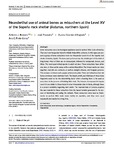Neanderthal Use of Animal Bones as Retouchers at the Level XV of the Sopeña Rock Shelter (Asturias, Northern Spain)

Use este enlace para citar
http://hdl.handle.net/2183/34739
Excepto si se señala otra cosa, la licencia del ítem se describe como Atribución-NoComercial-SinDerivadas 4.0 Internacional
Colecciones
- Investigación (FCIE) [1259]
Metadatos
Mostrar el registro completo del ítemTítulo
Neanderthal Use of Animal Bones as Retouchers at the Level XV of the Sopeña Rock Shelter (Asturias, Northern Spain)Fecha
2023-12-14Cita bibliográfica
Romero, A. J., Yravedra, J., Grandal-d'Anglade, A., & Pinto-Llona, A. C. (2023). Neanderthal use of animal bones as retouchers at the Level XV of the Sopeña rock shelter (Asturias, northern Spain). International Journal of Osteoarchaeology, 33(6), 1064–1079. https://doi.org/10.1002/oa.3267
Resumen
[Abstract] Bone retouchers are a technological appliance used to perfect lithic tools efficiently. They are most frequently found in Middle Palaeolithic contexts. In this paper, we present a group of bone retouchers from the Mousterian Level XV of the Sopeña rock shelter (Asturias, Spain). The bone part preferred was the middle part of the shaft of long bones: Most of them are on metacarpals, followed by metatarsals, femurs, and tibias. The most used animal species is adult red deer. These retouchers have either one, two, or three active areas, with a central disposition. The impact marks are close together; oval pits are common, as well as straight, sinuous, and irregular grooves. The surfaces on these marks appear pitted and scaled. There are indications that the bones employed were relatively fresh. The length, width, and thickness of those bone fragments seem to be the determining factor when choosing them to be used as retouchers in the process of finishing lithic tools. The formats documented in Sopeña Level XV are similar to those found in other Mousterian sites in Iberia, although there is a certain variability regarding their width. The Neanderthals of Sopeña acquired the raw material for these retouchers from the faunal remains generated in the process of butchering and eating the animals. These retouchers were used as implements to perfect lithic tools made mainly on quartzite, and they were used repeatedly and maybe for a long time.
Palabras clave
Bone retouchers
Bone technology
Cantabrian region
Middle Palaeolithic
Mousterian
Neanderthal
Bone technology
Cantabrian region
Middle Palaeolithic
Mousterian
Neanderthal
Versión del editor
Derechos
Atribución-NoComercial-SinDerivadas 4.0 Internacional
ISSN
1099-1212






